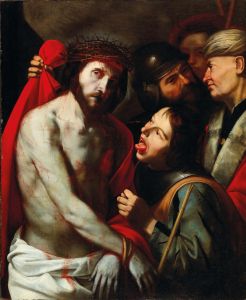
The Tears of Saint Peter
A hand-painted replica of Jusepe de Ribera’s masterpiece The Tears of Saint Peter, meticulously crafted by professional artists to capture the true essence of the original. Each piece is created with museum-quality canvas and rare mineral pigments, carefully painted by experienced artists with delicate brushstrokes and rich, layered colors to perfectly recreate the texture of the original artwork. Unlike machine-printed reproductions, this hand-painted version brings the painting to life, infused with the artist’s emotions and skill in every stroke. Whether for personal collection or home decoration, it instantly elevates the artistic atmosphere of any space.
"The Tears of Saint Peter" is a painting by the Spanish Baroque artist Jusepe de Ribera, also known as José de Ribera. Ribera was a prominent painter and printmaker of the 17th century, renowned for his dramatic use of chiaroscuro and his realistic depiction of human emotion. He spent most of his career in Italy, particularly in Naples, where he became a leading figure in the Neapolitan school of painting.
This particular work, "The Tears of Saint Peter," captures a poignant moment in the life of Saint Peter, one of Jesus Christ's apostles. The painting depicts the biblical episode following Peter's denial of Jesus, as recounted in the New Testament. According to the Gospels, Peter denied knowing Jesus three times before the rooster crowed, fulfilling Jesus' prophecy. Overcome with remorse and guilt, Peter wept bitterly, an event that has been a popular subject in Christian art due to its deep emotional and spiritual significance.
Ribera's interpretation of this scene is marked by his characteristic realism and attention to detail. The painting focuses on the figure of Saint Peter, who is shown in a moment of intense introspection and sorrow. Ribera's use of light and shadow enhances the emotional impact of the scene, highlighting Peter's tear-streaked face and the texture of his garments. The artist's skillful rendering of Peter's expression conveys a profound sense of repentance and humanity, inviting viewers to empathize with the apostle's inner turmoil.
The composition of the painting is relatively simple, with Peter occupying the central position. Ribera's choice to isolate Peter in this manner emphasizes the personal nature of his anguish and the gravity of his spiritual crisis. The background is typically dark, a common feature in Ribera's work, which serves to draw attention to the illuminated figure of Peter and to create a dramatic contrast that underscores the emotional intensity of the scene.
Ribera's "The Tears of Saint Peter" is an excellent example of the Baroque style, characterized by its emphasis on realism, emotional depth, and dramatic use of light and shadow. The painting reflects Ribera's mastery of these elements and his ability to convey complex human emotions through his art. It also illustrates the Baroque period's interest in religious themes and the exploration of personal faith and redemption.
This work is part of Ribera's broader oeuvre, which includes numerous religious subjects, as well as mythological and genre scenes. His paintings are noted for their vivid realism and often feature figures depicted with a striking honesty and attention to physical detail. Ribera's influence extended beyond his lifetime, impacting both his contemporaries and later generations of artists.
"The Tears of Saint Peter" remains a significant piece within Ribera's body of work and continues to be appreciated for its artistic and emotional depth. It exemplifies the artist's ability to capture the complexities of human emotion and the spiritual struggles that define the human experience.
















